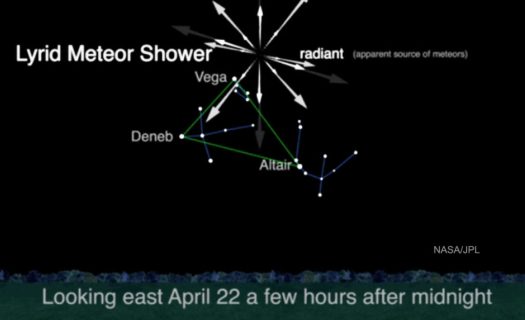
In late April each year, we see the return of the Lyrid meteor shower. It may not be the most spectacular meteor shower of the year, but I find it easier to observe. That’s because, in our part of the world, it comes at a time when the weather is mild enough to sit outside and watch (unlike the Geminids in December) and before mosquitoes become a problem (as with the August Perseids shown in the picture).
This year, the return of the Lyrid meteor shower is from April 14-30, with the peak on the night of April 22. Typically, the Lyrids display five to 20 meteors per hour at the peak, although, in some years, the number has been higher. Written records of the Lyrid meteor shower go back 2700 years when Chinese astronomers made note of it in 687 B.C. A Korean account from A.D.1136 says that “many stars flew from the northeast.”
If you see the Lyrid meteor shower, you will not be looking at falling stars, although you may get that impression. Instead, you will see tiny fragments of Comet Thatcher (officially C/1861 G1), discovered in 1861 by amateur astronomer A.E. Thatcher. That year was the last time the comet flew by our planet at 31.1 million miles (50.1 million km). Its next return to our vicinity will be sometime around the year 2280. Meanwhile, Earth’s orbit around the Sun causes us to pass through debris the comet left behind. So we see those fragments as they burn up from the effect of atmospheric friction.
We live in an orderly universe on a planet positioned to allow observation and study of the cosmos. Our planet is designed with an atmosphere and magnetic field to protect us from comet debris, meteorites, cosmic rays, and solar wind. If you have the opportunity to observe the return of the Lyrid meteor shower, use it as a time to thank the Creator for allowing us to live in the just-right time on a just-right planet in a just-right location in the universe.
— Roland Earnst © 2022


